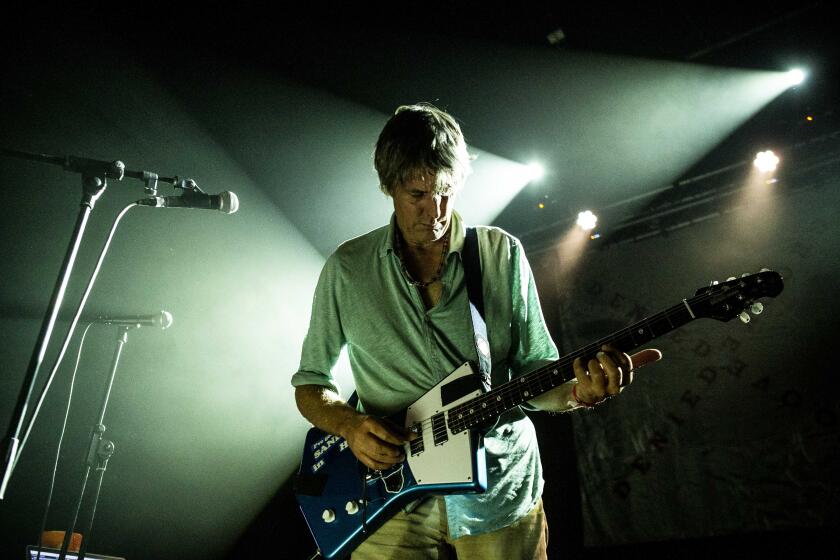Detroit’s tribute to black struggles
It was known as the Middle Passage, the journey from West Africa to the New World. The chained slaves--Africans often in their early teens--were tightly packed in the ship’s hold.
Over a 400-year period, about 2,500 ships made the journey. There is a painful irony to some ships’ names: Gift of God, Brotherly Love, Deliverance, Good Intent. A third of the enslaved passengers died on the trip.
This gruesome odyssey is the defining event that shaped the history of Africans in America. Fittingly, its depiction is the centerpiece of the newly expanded Museum of African American History, which opens here Saturday as the world’s largest facility devoted solely to black history and culture.
The museum’s permanent exhibit holds an 80-foot replica of a slave ship, including sculptures of 50 African youths--castings made from Detroit teens--held in bondage. The ship’s hull bears the name of each vessel that carried slaves to this country.
“You cannot help but be moved by this,” said Kimberly Camp, director of the $39-million, 120,000-square-foot facility, which was funded with taxpayer dollars as well as individual and corporate donations.
For many in Detroit--which has a population that is 80% black and is the nation’s largest majority minority city--the museum is a long-overdue recognition of the contributions blacks have made to the nation, as well as a concrete symbol of Detroit’s economic and emotional revival.
“The museum adds another cultural dimension to Detroit,” said Mayor Dennis Archer. “It adds to our rich tradition of diversity.”
The expansion fulfills the dream of Dr. Charles Wright, who founded the institution in 1965 with a display of African American artifacts in two West Side houses. It moved to a city-owned facility in 1987, but was too small to attract much attention.
In 1992, then-Mayor Coleman A. Young--Detroit’s first black mayor--convinced voters to pass a $20-million bond proposal to build a first-class African American museum. Archer embraced the idea and successfully pushed a $10-million bond issue for the museum in 1995. The remaining funding came from individuals and corporations, including the Big Three auto makers, K mart, Ameritech and local banks.
“To build a museum of the size and scope of this in this day and age is a particularly spectacular achievement,” said Edward Able, president and chief executive of the American Assn. of Museums.
Many of the nation’s 8,000 museums are under financial pressure as government has limited funding for the arts and as competition among nonprofit groups for private dollars has intensified. There are about 150 African American museums nationwide, but up to 15% fail annually.
The Detroit museum, located in the city’s cultural district, has an annual budget of $6.2 million. Museum officials said they hope to attract 500,000 visitors a year by aggressively marketing it outside the Detroit area and to spur other cities to open similar facilities.
The expanded museum already is being touted as the latest evidence of this city’s comeback from financial devastation. In the last four years, Detroit has seen a spark of economic development as Archer has tried to build bridges to suburban communities and businesses. Two new sports stadiums are planned for downtown, three casinos will follow and manufacturing investment has increased.
The museum’s future hinges on its ability to attract a more diverse audience from beyond Eight Mile Road, the city’s northern border. In recent years, it has only attracted 30,000 visitors a year, almost all black.
The museum is positioning itself not only as a place to view art and artifacts, but also as an educational forum and community center where ideas can be discussed and exchanged.
Designed by black-owned Sims-Varner Architects of Detroit, the museum features a circular design topped by a glass dome 100 feet in diameter and sculpted columns with an African rope motif. Two 250-pound aluminum and gold-plated steel African masks are displayed above the bronze entrance doors. The entrance leads to a rotunda featuring a terrazzo floor design depicting figures stretching across the ocean and spanning two continents.
The museum’s permanent exhibit, “Of the People: The African American Experience,” is housed in a 16,000-square-foot area and represents the largest exhibition ever created about the nation’s blacks.
Among the more than 100 artifacts displayed are unpublished chapters of “The Autobiography of Malcolm X,” the first stoplight invented by Garrett Morgan and the dress worn by Carlotta Walls, one of the nine black children who integrated Central High School in Little Rock, Ark.
More to Read
The biggest entertainment stories
Get our big stories about Hollywood, film, television, music, arts, culture and more right in your inbox as soon as they publish.
You may occasionally receive promotional content from the Los Angeles Times.






